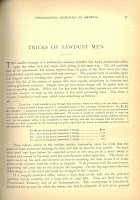 We have all been recipients of a certain type of e-mail, usually from someone claiming to be the heir to a sizable fortune or the representative of a financial institution based in Nigeria. Predictably, they all need help to transfer a significant amount of money in a covert and speedy fashion and promise a tempting percentage for whomever assists them. Although the technology is relatively new, this sort of swindle is at least over a hundred years old. Back in the late nineteenth century, con artists called "sawdust men" cast a similar net for unsuspecting victims by mailing out flyers, or circulars, to individuals they had identified as being particularly susceptible to these kinds of offers. The circulars offered to sell the recipient a large amount of counterfeit money in exchange for a smaller amount of actual cash. Once the sucker had been shown the funny money and had paid for it, the sawdust men would distract him or her while exchanging the bag full of counterfeit currency for one filled with nothing but sawdust. Much later, after the trick was discovered, the victim was usually left without recourse; to incriminate the sawdust men would be to reveal that they themselves had also planned to conduct illegal activity.
We have all been recipients of a certain type of e-mail, usually from someone claiming to be the heir to a sizable fortune or the representative of a financial institution based in Nigeria. Predictably, they all need help to transfer a significant amount of money in a covert and speedy fashion and promise a tempting percentage for whomever assists them. Although the technology is relatively new, this sort of swindle is at least over a hundred years old. Back in the late nineteenth century, con artists called "sawdust men" cast a similar net for unsuspecting victims by mailing out flyers, or circulars, to individuals they had identified as being particularly susceptible to these kinds of offers. The circulars offered to sell the recipient a large amount of counterfeit money in exchange for a smaller amount of actual cash. Once the sucker had been shown the funny money and had paid for it, the sawdust men would distract him or her while exchanging the bag full of counterfeit currency for one filled with nothing but sawdust. Much later, after the trick was discovered, the victim was usually left without recourse; to incriminate the sawdust men would be to reveal that they themselves had also planned to conduct illegal activity.
The details of this scam, along with many others, is described in Professional Criminals of America, a 1886 publication written by Thomas Byrnes. Byrnes, the NYPD Detective Bureau chief from 1880 until 1895, ostensibly published his book "pro bono publico" in order to keep members of the public from falling prey to less scrupulous members of society. His tome is filled with all manner of interesting facts about the criminal underground, including the habits and strategies of bank robbers, pickpockets and even fradulent horse salesmen. In addition to criminal methodology, Byrnes includes many photographs and biographies of notorious criminals who have apparently been in the business for quite some time. For example, he warns us about Charles Smyth, alias Doctor Smyth, alias Harrison, who is considered a "clever hand" at the "confidence and sawdust game," despite having been arrested and imprisoned for twelve months earlier that year.
It is fascinating to think that the pool of usual suspects in the New York City area would have been so small as to be able to fit them all into a single volume. The power of the photograph was such that the appearance of these ne'er-do-wells' pictures in a popular book apparently was considered sufficient remedy against future deception. What is more likely is that Byrnes was attempting to leverage his national renown into a profitable publishing venture. He had garnered national recognition in 1878 after solving a challenging bank heist, and he continued to grow in fame throughout his fifteen-year stint as the head of the city's detective unit.
However, despite his popularity, Byrnes also had a shady reputation himself; his interrogation rooms
were more like torture chambers, and Byrnes is claimed to have coined the term "third degree" in reference to his information-extracting behavior. Ultimately, in 1895, he was firmly encouraged to retire as a move to rid the police force of corruption by none other than Theodore Roosevelt, who at the time was the president of the NYC Police Commission.
To learn more about how to protect yourself from the trickery of nineteenth-century scam artists, come to Rauner and ask to see Rare HV6785 .B9.








